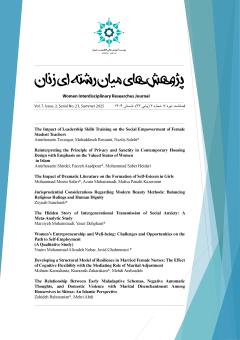-
-
-
Open Access Article
1 - Strategies to deal with the collapse of the family unit based on the teachings of the Holy Quran (The verses of Surah Talaq)
Ebrahim Kalantari Fateme Layeghi -
Open Access Article
2 - The Effectiveness of Schema Therapy on Increasing Self-Efficacy and Life Expectancy of Divorced Women and its Effect on Reducing the Initial Maladaptive Patterns of their Daughters
Mojtaba Aghili Arezou Asghari mitra namazi -
Open Access Article
3 - Estimation of conflict between couples and solutions based on the secondary analysis of national family survey data in Iran
Akbari younes Mohammad Torkashvand -
Open Access Article
4 - Comparison of Spiritual Health and Psychological Helplessness in Adolescent Girls from Divorced and Normal Families in Shiraz
zahra Ghaedian soode dashtiane Nasir Dastan -
Open Access Article
5 - Qualitative Assessment of the Efficiency of Pre-Divorce counseling: A Study on the Second Chapter of the Family Support Law Based on the clients’ Perspectives on Counseling Centers in Alborz province.
Mehri Allahverdi Mohsen Badre Fatemeh Pour-masjedian -
Open Access Article
6 - The Effect of Solution-Focused Counseling on Parenting Among Divorced Mothers
Roghayeh Emamei Narges Arab moghadam
List of Articles Divorce
-
The rights to this website are owned by the Raimag Press Management System.
Copyright © 2017-2025


